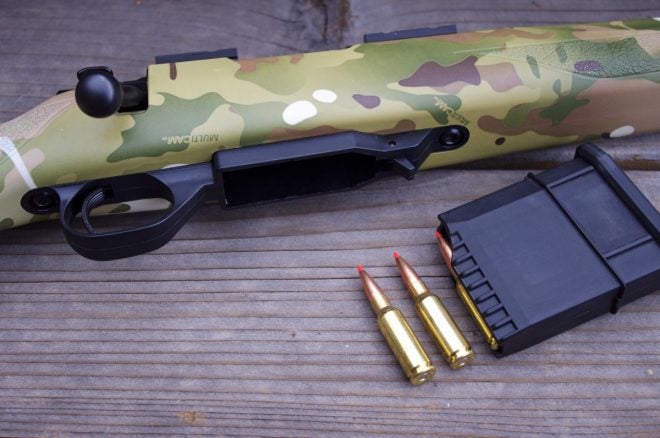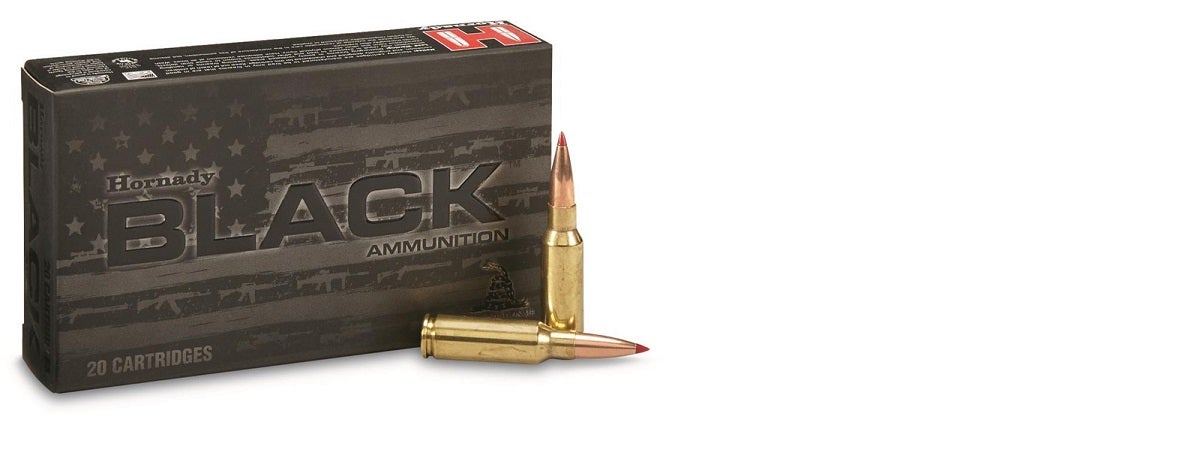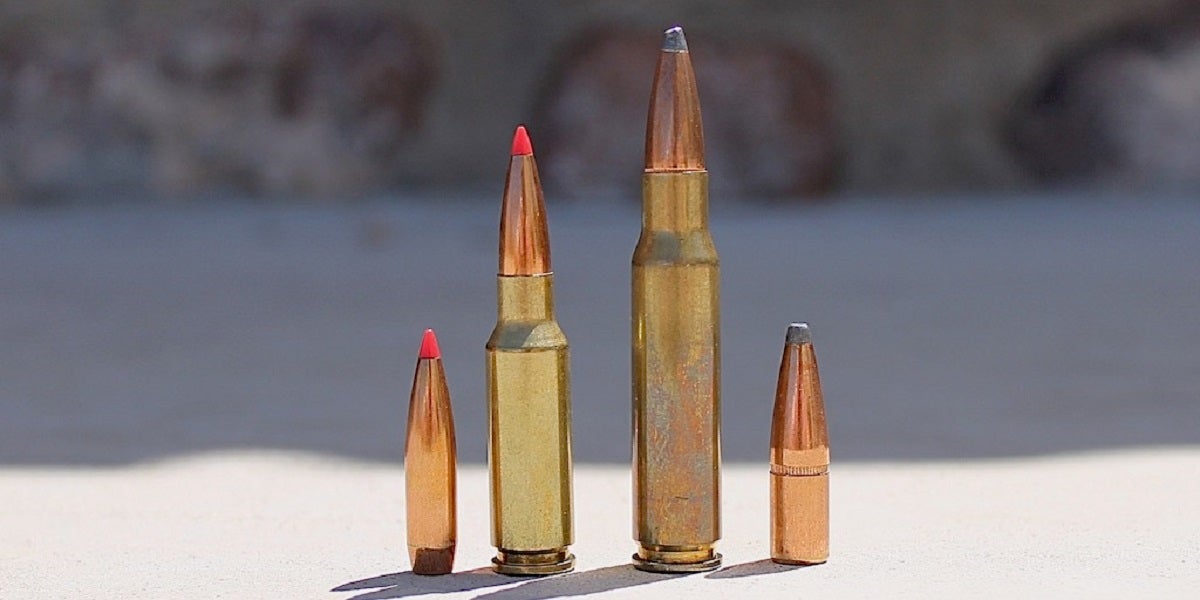Why 6.5 Grendel is One of The Best Deer Cartridges
Travis Olander 03.16.23

It’s fast, small, and 24 years old, but many shooters are still discovering its unique advantages: The 6.5 Grendel is one helluva deer round, and for plenty of good reasons. We’re going to cover all that justification but first, let’s introduce the Grendel properly.
Designed For Combat in 2002
Developed by Hornady in 2002 and introduced officially in 2003, the 6.5 Grendel predates the larger 6.5 Creedmoor. It was designed to replace the military’s 5.56 NATO cartridge while using the same STANAG magazines, and without requiring substantial changes to the standard-issue service rifle.
Hornady succeeded: The Grendel provides superior ballistics and terminal performance while making use of M4/AR platform’s original components save, of course, for the barrel and bolt.
6.5 Grendel Specs at a Glance
Factory Grendel loads range between 90 and 130 grains, averaging about 2,500 to 2,900 ft/s out of the muzzle, with muzzle energy varying between about 1,650 ft-lbs. and 1820 ft-lbs. Compared to 5.56 NATO, it’s capable of providing roughly 27% to 40% more energy at the starting line. The fat, squat Grendel packs in a case capacity of 35 gr H2O and maxes out at roughly 52,000 PSI in the chamber.
Compared to 5.56 and .223 loads, the Grendel manages to, on average, provide nearly twice the energy at 500 yards: Grendel’s 123-grain ELD affords roughly 750 ft-lbs. compared to 5.56 NATO’s 62-grainers yielding about 346 ft-lbs.
Of course, most folks don’t use 5.56 or .223 for deer. We’re merely providing the comparison for a bit of context — the Grendel is, after all, made for the AR platform. But that brings us to why you should consider the Grendel over other popular AR-compatible hunting loads.
Why Grendel’s Great for Hunting
Lightweight Performance
With an overall length of just 2.26 inches, the Grendel can fit handily in any short-action rifle. Like the awesome Howa Mini, which boasts a 6″ bolt weighing just 10.2 oz, and an overall weight of just 4.9 pounds.
By sticking with a skinny 0.264″ bullet, the average Grendel gun gets away with running a svelte barrel that reduces weight significantly when compared to other popular hunting cartridges.
That also means the Grendel provides plenty of opportunity to kit out an AR-15 for American game. Modern sporting rifles are replacing many bolt guns. But most hunting cartridges are designed for the long-action AR, based on the LR-308 platform. With larger receivers and barrels, the 308-type AR is noticeably heavier.
Pair that bigger AR with, say, heavy mags loaded up with some .308 Winchester or 6.5 Creedmoor, and you’ll find yourself lugging around way more bulk in the back country than you really need to.
But can the small Grendel edge out these larger cartridges and reliably down the game you’re tracking? Yes.
6.5 Grendel vs .308 Winchester
Good ole’ .308 continues to reign as a popular American game cartridge. The average 146-grainer punches with about 2,470 ft-lbs. of muzzle energy and it exits the barrel at a respectable 2,750 ft/s. Compared to the standard 123-grain Grendel, that’s similar speed (just 100 ft/s more) but about 29% more power.
Is that extra power downrange necessary for most game? No. And the Grendel cartridge beats the archaic .308 Winchester in just about every other category: A Grendel-chambered rifle will benefit from the smaller action, lighter barrel, and overall lesser weight and more compact size.
At distances beyond 500 yards, .308 Winchester provides noticeable performance gains over Grendel — at least when you’re hand loading match bullet. Within 200 yards, wherein virtually all game-taking shots are made, both loads have practically identical bullet drop and windage affects: The 123-grain Grendel drops 4.51 inches and drifts 2.97″, compared to the .308’s best-in-class, 190-grain ABLR’s 4.24″ of drop and 1.11″ of drift.
6.5 Grendel vs 6.5 Creedmoor
You’d think the newfangled Creedmoor would substantially beat its smaller cousin, but that’s simply not the case. Yet again comparing the typical 123-grain Grendel to a 143-grain Creedmoor, we find only marginal differences in bullet drop at game ranges:
With a 200-yard zero, Grendel yields +2.2″ on the horizon compared to Creedmoor’s +1.9″. Out to 500 yards, Grendel drops 52.8″ compared to Creedmoor’s 44.4″. Power at hunting distances isn’t drastically worse with Grendel, either. At 200 yards, Grendel affords about 1,375 ft-lbs. versus Creedmoor’s 1,858 ft-lbs.
That’s just 15% less drop and 25% more power, in exchange for more powder and brass, higher cost per round, more recoil, less barrel life, and a longer action with a heavier bolt, receiver, magazine, and barrel.
Felt Recoil
Being “tough” and having a trained reaction to recoil is great, but nothing beats reducing the felt impulse to something equivalent to a light tap. Grendel, on average maintains about 9.1 ft-lbs. of free recoil energy.
Compare this to the .308: A 146-grainer punches with about 15.5 ft-lbs. of recoil energy. Grendel yields more than 40% less felt recoil. Grendel also beats Creedmoor’s 11.8 ft-lbs. of energy by a fair margin (~23%).
This makes Grendel the perfect choice for female and youth shooters, who simply have less bulk to mitigate that felt impulse.
Takedown Power
When it comes to bagging deer without chasing down a runaway, the magic number is generally accepted to be 1,000 ft-lbs. of required terminal energy. The 6.5 Grendel manages this easily: Its 123-grain loads manage over 1,024 ft-lbs. at 400 yards. You probably aren’t risking a trophy shot beyond 300 yards, where the same load manages 1,193 ft-lbs. ‘Nuff said.
Cost Per Round
At the time of this publication, we’re able to find high-end, match 6.5 Grendel loads averaging about $2.00 to $2.25 per round. All-purpose FMJBTs for hunting and target shooting come in at around $1.60 to $1.80.
Compare that to 6.5 Creedmoor, which averages at least $1.80 to $3.00, and other “niche,” short-action cartridges like .224 Valkyrie ($1.65 to $2.50), 6mm ARC ($1.75 to $2.15), and 6.8 SPC ($1.50 to $2.00), and we find that Grendel is much more widely produced and affordable than it was when it was introduced two decades ago.
(It’s a Great Tacticool Round, Too)
The more guns you own in different calibers, the more expensive the shooting hobby becomes. It makes sense to invest in rifles and firearms that share cartridges, and we’re seeing 6.5 Grendel becoming more widely adopted in top platforms.
We’ve already covered how the Grendel was purpose-built for the AR. But we’re now also seeing some pretty cool rifles make use of this round: Zastava’s M19 MCS is available chambered in Grendel, and Palmetto State Armory’s bringing the Grendel to their “American AK” (which we got to inspect at SHOT Show 2023). Love bullpups? Kel-Tec’s RDB will be featuring this short 6.5 at some point, too.


